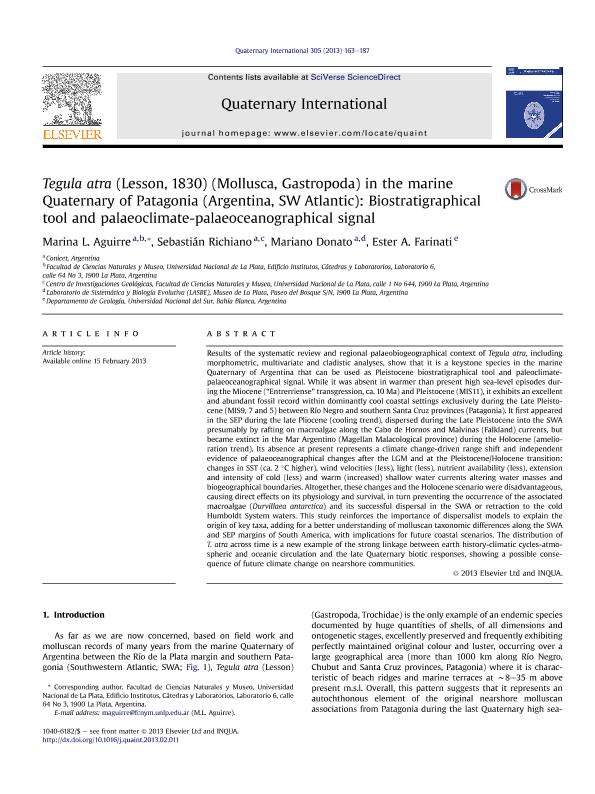Artículo
Tegula atra (Lesson, 1830) (Mollusca, Gastropoda) in the marine Quaternary of Patagonia (Argentina, SW Atlantic): Biostratigraphical tool and palaeoclimate-palaeoceanographical signal
Aguirre, Marina Laura ; Richiano, Sebastian Miguel
; Richiano, Sebastian Miguel ; Donato, Mariano Humberto
; Donato, Mariano Humberto ; Farinati, Ester Amanda
; Farinati, Ester Amanda
 ; Richiano, Sebastian Miguel
; Richiano, Sebastian Miguel ; Donato, Mariano Humberto
; Donato, Mariano Humberto ; Farinati, Ester Amanda
; Farinati, Ester Amanda
Fecha de publicación:
02/2013
Editorial:
Elsevier
Revista:
Quaternary International
ISSN:
1040-6182
Idioma:
Inglés
Tipo de recurso:
Artículo publicado
Clasificación temática:
Resumen
Results of the systematic review and regional palaeobiogeographical context of Tegula atra, including morphometric, multivariate and cladistic analyses, show that it is a keystone species in the marine Quaternary of Argentina that can be used as Pleistocene biostratigraphical tool and paleoclimate-palaeoceanographical signal. While it was absent in warmer than present high sea-level episodes during the Miocene (“Entrerriense” transgression, ca. 10 Ma) and Pleistocene (MIS11), it exhibits an excellent and abundant fossil record within dominantly cool coastal settings exclusively during the Late Pleistocene (MIS9, 7 and 5) between Río Negro and southern Santa Cruz provinces (Patagonia). It first appeared in the SEP during the late Pliocene (cooling trend), dispersed during the Late Pleistocene into the SWA presumably by rafting on macroalgae along the Cabo de Hornos and Malvinas (Falkland) currents, but became extinct in the Mar Argentino (Magellan Malacological province) during the Holocene (amelioration trend). Its absence at present represents a climate change-driven range shift and independent evidence of palaeoceanographical changes after the LGM and at the Pleistocene/Holocene transition: changes in SST (ca. 2 °C higher), wind velocities (less), light (less), nutrient availability (less), extension and intensity of cold (less) and warm (increased) shallow water currents altering water masses and biogeographical boundaries. Altogether, these changes and the Holocene scenario were disadvantageous, causing direct effects on its physiology and survival, in turn preventing the occurrence of the associated macroalgae (Durvillaea antarctica) and its successful dispersal in the SWA or retraction to the cold Humboldt System waters. This study reinforces the importance of dispersalist models to explain the origin of key taxa, adding for a better understanding of molluscan taxonomic differences along the SWA and SEP margins of South America, with implications for future coastal scenarios. The distribution of T. atra across time is a new example of the strong linkage between earth history-climatic cycles-atmospheric and oceanic circulation and the late Quaternary biotic responses, showing a possible consequence of future climate change on nearshore communities.
Palabras clave:
Tegula
,
Biostratigraphy
,
Paleoclimatology
,
Paleooceanography
Archivos asociados
Licencia
Identificadores
Colecciones
Articulos(CCT - LA PLATA)
Articulos de CTRO.CIENTIFICO TECNOL.CONICET - LA PLATA
Articulos de CTRO.CIENTIFICO TECNOL.CONICET - LA PLATA
Citación
Aguirre, Marina Laura; Richiano, Sebastian Miguel; Donato, Mariano Humberto; Farinati, Ester Amanda; Tegula atra (Lesson, 1830) (Mollusca, Gastropoda) in the marine Quaternary of Patagonia (Argentina, SW Atlantic): Biostratigraphical tool and palaeoclimate-palaeoceanographical signal; Elsevier; Quaternary International; 305; 2-2013; 163-187
Compartir
Altmétricas



